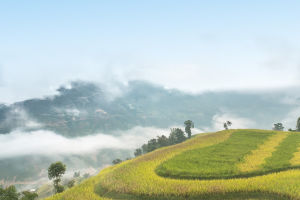Snowy River fog in winter emerges as a mesmerizing natural spectacle, resulting from the confluence of cold temperatures, water vapor, and particular geographic settings.
This phenomenon transforms river landscapes into enchanting winter wonderlands, with a frosty white layer cloaking the surroundings. However, this scenic beauty is not merely a fortuitous event but the outcome of specific climatic and geographical factors.
The formation of snowy river fog typically occurs during the colder winter months, when temperatures dip below freezing. In such conditions, water vapor in the air condenses on objects like tree branches and grass leaves, leading to the creation of exquisite ice crystals. This transformation of water vapor directly into ice is known as deposition. This process takes place when the air is heavily laden with moisture, and the surface temperature of objects falls below the freezing point. Under these precise conditions, ice crystals develop, adorning the environment with a snowy, frost-like layer that adds a magical touch to the winter scenery.
Geographical conditions significantly contribute to the formation of snowy river fog in winter. This phenomenon is more prevalent in areas abundant in water bodies, such as rivers, lakes, and oceans. These water bodies emit moisture into the air, which subsequently freezes into ice crystals as temperatures drop below the freezing point.
Moreover, valleys and low-lying areas are particularly susceptible to snowy river fog during winter due to their geographic positioning. Often enclosed by mountains or hills, these areas can trap cold air, leading to a phenomenon known as temperature inversion. This situation results in a layer of cold air being trapped under a layer of warmer air above. Consequently, the water vapor in the cold air layer condenses and forms ice crystals, contributing to the enchanting frosty landscape.
While snowy river fog in winter is a captivating natural occurrence, it can also pose certain risks. Accumulation of snow and ice on tree branches can lead to branches becoming weighty and breaking, potentially falling onto power lines or structures and causing damage. Additionally, icy conditions on roads and bridges present hazards for drivers and pedestrians, increasing the likelihood of accidents and injuries. Thus, while this phenomenon is visually stunning, it necessitates caution and awareness of its potential impacts.
In summary, snowy river fog in winter is a remarkable and picturesque natural occurrence that manifests when temperatures plummet below freezing, leading to the condensation of water vapor on various objects, resulting in the formation of ice crystals.
This phenomenon is contingent upon certain climatic and geographic conditions, frequently arising in regions abundant in water bodies and valleys encircled by mountains.
While it presents a stunning visual spectacle, it also carries potential dangers to people and their environment. Therefore, it is essential to recognize the risks associated with this phenomenon and to exercise caution, taking appropriate measures to prevent accidents and ensure safety.


